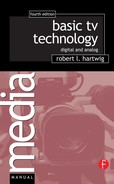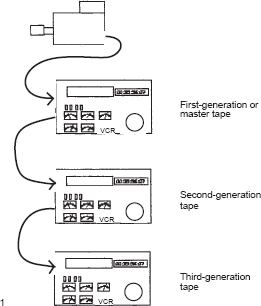Editing gives you flexibility.
Editing Analog Videotape
Physical Cutting and Splicing
In the early days of videotape, editing was a difficult and time-consuming process. A liquid solution had to be put on the tape to make the control track oxide patterns visible. The tape had to be viewed under magnification, and then it was physically cut. Finally, the ends were spliced together with a special tape. The roughness that the splice created in the tape's surface often damaged or even destroyed the tape head. Needless to say, editing tape was done only when there was no other alternative.
Electronic Editing
Today video editing is done electronically. Information that should be sequential may be out of order on one tape, or it may be distributed among several different tapes. During editing, the material is recorded electronically in the proper sequence onto another tape. The process of copying information from one tape to another is called dubbing. Whenever we dub a tape, we drop a generation. The original tape that the video is recorded onto is called the master or first-generation tape. If we make a copy of that tape, it is a second-generation tape. If a dub is made of the second-generation tape, the resulting tape becomes a third-generation tape, and so on.
Every generation drop also entails a loss of quality. The signal has to go through the entire electronics of a tape recorder, be recorded onto the tape, taken off the tape, and run to another tape recorder. Every step of this process adds more noise to the signal and diminishes the original quality of the signal. A top-rated VTR can go several generations before this quality loss becomes visible to the human eye. However, a low-quality machine, such as a home VTR, will show a very visible quality loss on a second-generation tape. (You may refer to your home machine as a VCR which stands for videocassette recorder. VTR is short for videotape recorder, so VTR applies to all videotape machines while VCR applies to only those machines that have the tape contained in a plastic enclosure.)
Editing allows you to shoot a video production in the most efficient manner, which often means shooting scenes out of sequence from the script. These disconnected scenes can then be rearranged and put together in sequence in the editing suite. The second figure shows the master tape, with the shots in nonsequential order. Through the editing process, the shots or scenes are arranged into their proper sequence.

1. Tape generations.
2. Tape editing.

